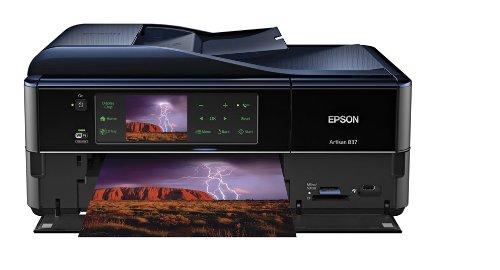Computer See Epson Artisan 837 Wireless All-in-One Color Inkjet Printer, Copier, Scanner, Fax, iOS/Tablet/Smartphone/AirPrint Compatible (C11CB20201) Details
Product Description
Enjoy the best of both worlds with this wireless all-in-one inkjet printer that features a combination of compact design and powerful performance. MicroPiezo® technology provides the finest color and detail for producing better-than-lab-quality photos without sacrificing speed. Free downloadable apps give you the tools to print wirelessly from your mobile device. Smart touch panel&rsquos large display lights up only the buttons you need to make completing tasks easier. Automatic document feeder is great for quickly copying faxing and scanning stacks of originals. Auto Photo Correction restores color and removes red eye in your scanned pictures bringing them back to life. Print Technology: Inkjet Maximum Print Speed (Black): 9.6 ppm Maximum Print Speed (Color): 9.1 ppm Network Ready: Yes.Unit of Measure : Each
- Rated no1 in photo quality by consumers
- World's Fastest 4x6 inch photo printer
- Fax 30page ADF and 7.8 inch touch panel
- Epson Connect to print from mobile devices
More About Epson Artisan 837 Wireless All-in-One Color Inkjet Printer, Copier, Scanner, Fax, iOS/Tablet/Smartphone/AirPrint Compatible (C11CB20201)
In the beginning, computer memory was created. It was fundamental in its architecture and really rough than the the computer memory of today. The time was the 1940s and 1950s. As sock hops entertained the children of that generation, the birth of computers and computer memory emerged to the use of businesses and large companies. Virtual memory was still a dream that hadn't had a chance to be dreamt and at the same time the speeds at And this the memory had to be accessed hadn't reached above a turtle's crawl compared to the today's standards.
Logic and simplified algorithms were the hot Products of the day and technologies brightest star. All large programs, Which when than the today's texts would nonetheless are already tiny, had to have them as a way to approach and Deal with two level storage-primary storage and secondary storage.
Then, the next stage of technology spurred from the depths of these meager beginnings and virtual memory was born. The technology that created virtual memory didn't feel the intent of extending primary memory, but rather of Producing such an extension possible and relatively easy for programmers to use since the very first computers were outgrown swiftly by the working world. It didn't take long to figure out that increasing what a computer can frequently do would increase the ability of business to create a profit and grow to be a household name.
The wide range of jobs that the computer could do was seen in the starting out as limited. with technological advancement, that view rapidly moved to limitless. This shift at the options of computer memory and in computers themselves led to a technological explosion as each aspect of each conceivable probability and possibility identified their way in to the think tanks of programmers and developers intent on increasing the functionality of the computer.
The 1960s saw even much more development, along with other particular strides in virtual memory. The B5000 hit the market Using the new technology and was designed for enterprise use, not personal use. Personal usage of computers waited at the wings, though it had not been the original intent when the development of computers began.
In 1969, virtual memory finally graduated from one a buggy concept along with other many problems using a heavy cost tag attached. IBM researched and proved its advantageous capabilities, moving virtual memory in one infancy to toddlerhood without having any further delays.
The 1970s saw the development of those minicomputers. These, of course, were not the minicomputers of today, but rather large in comparison. Still, they were the smallest computers of their day. The NORD1 didn't do badly at all around the market. The birth of those idea of a personal computer became the concentrate of these decade.
since the 70s, there are already so many changes Using the way computers were used, how they store and hold memory, and at the same time the purpose of computers. The late 70s and early 80s saw the computer begin the personal trek because it showed up in homes. No longer just for business, these computers were quite limited in their ability. The initial personal computers ran just several computer applications and didn't have significantly functionality for Producing the volume of work needed for home offices. By the 90s, this flaw could be rectified as the personal computer became a Popular and ordinary addition to homes.
By the 2000s, the home computer produced just as considerably revenue in one business, created a manufacturer new approach of shopping and balancing finances as their business counterparts. numerous businesses appear to be now individuals on a home computer working With all the same amount of competitive edge as companies who began the technological race for computerized functions years ago. As every milestone in technology has advanced, so has computer memory. Today, home computers use and possess the capacity to store large amounts of information. the buzz of computers will only increase as the choices in computer memory and other technology continually speeds up the value and functionality of those computer.
Epson Artisan 837 Wireless All-in-One Color Inkjet Printer, Copier, Scanner, Fax, iOS/Tablet/Smartphone/AirPrint Compatible (C11CB20201) Reviews
Epson Artisan 837 Wireless All-in-One Color Inkjet Printer, Copier, Scanner, Fax, iOS/Tablet/Smartphone/AirPrint Compatible (C11CB20201):Computer




